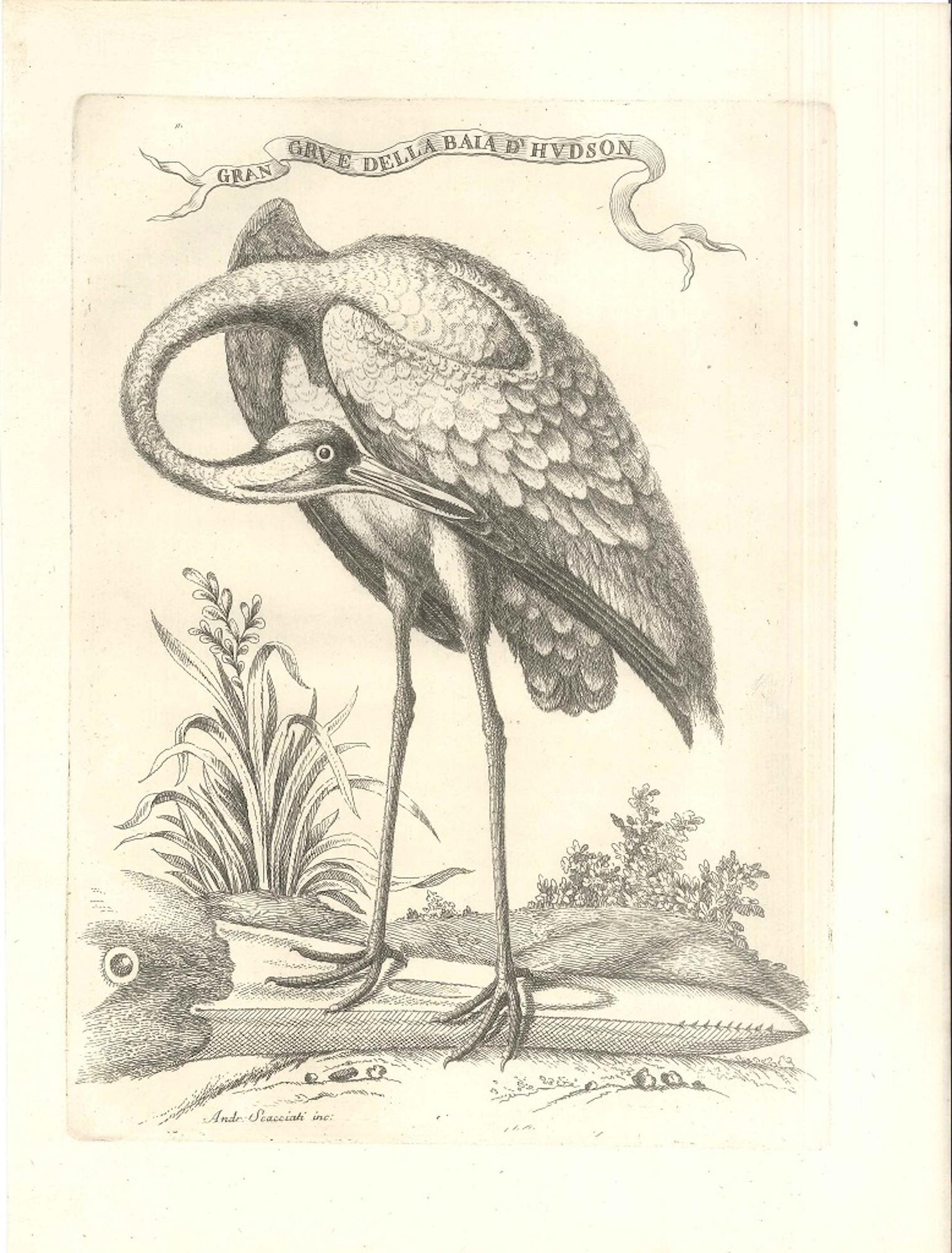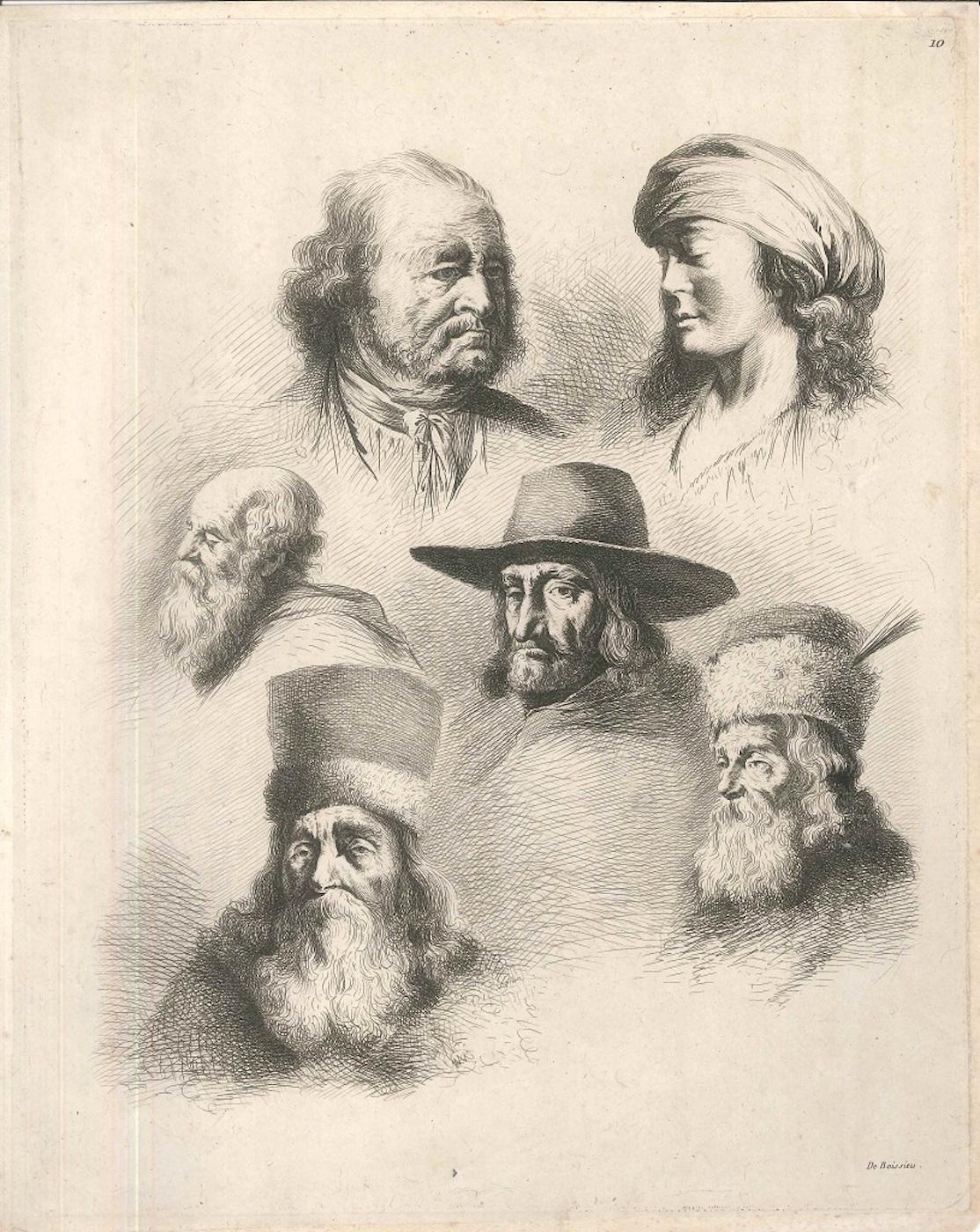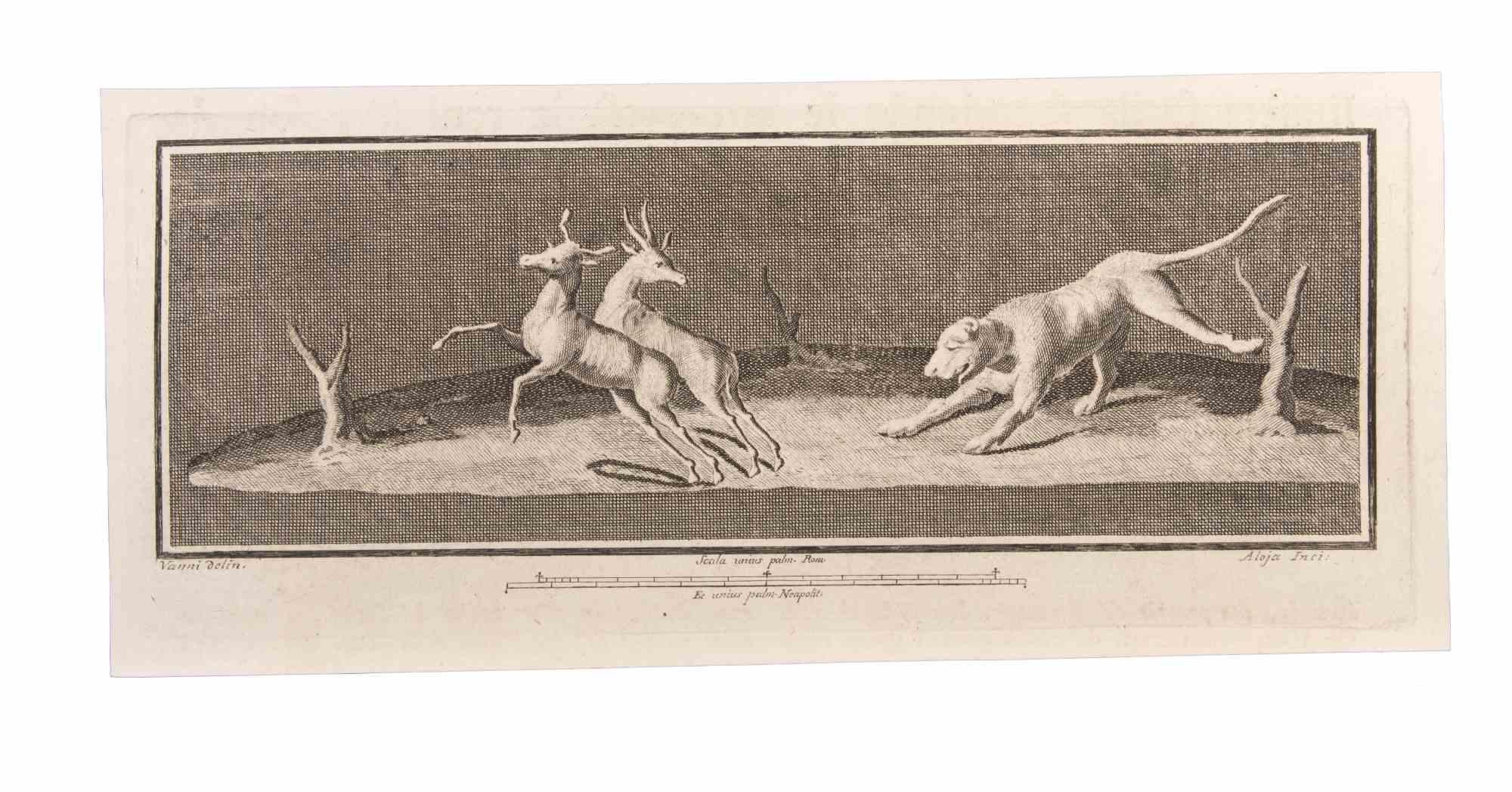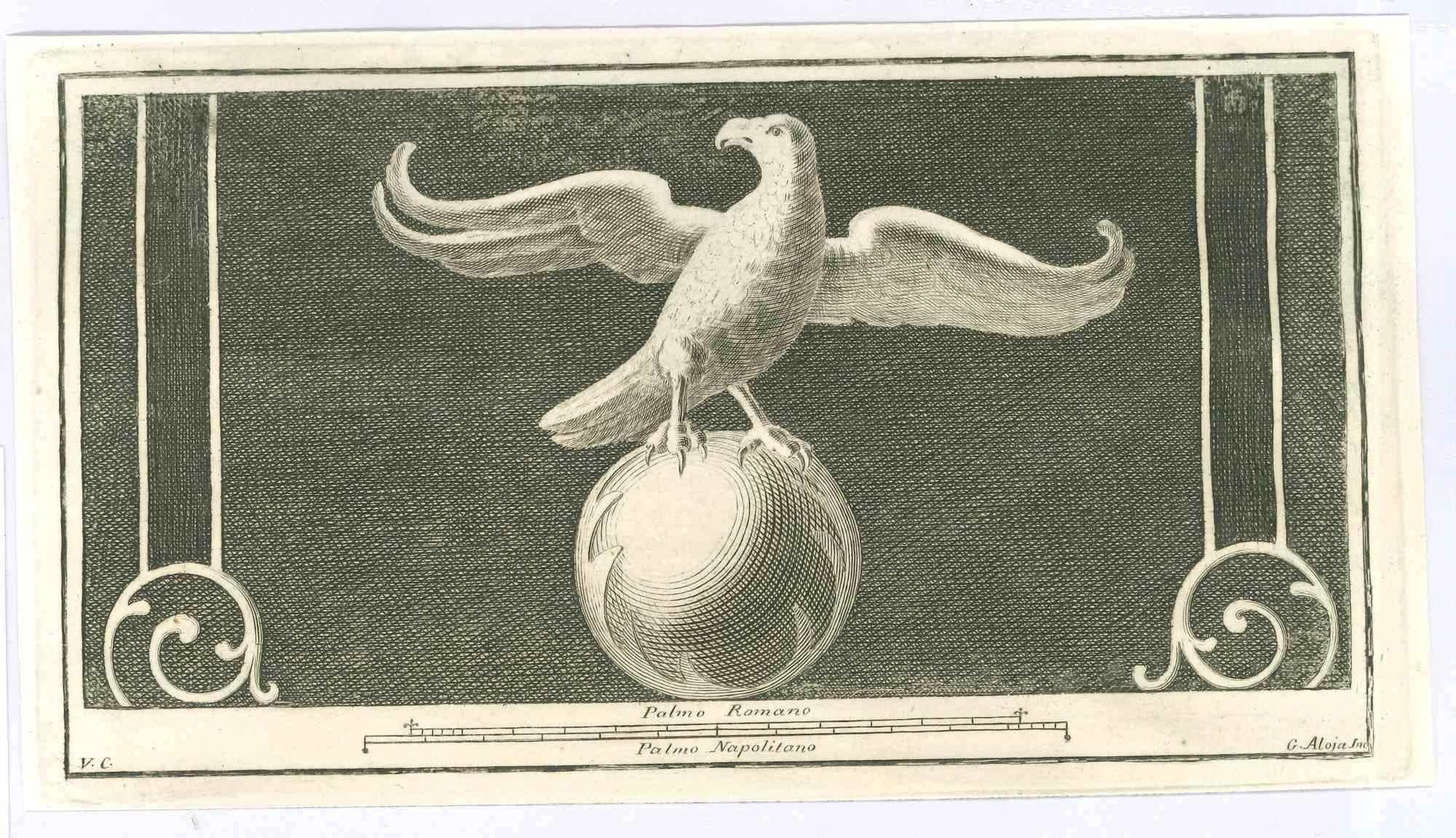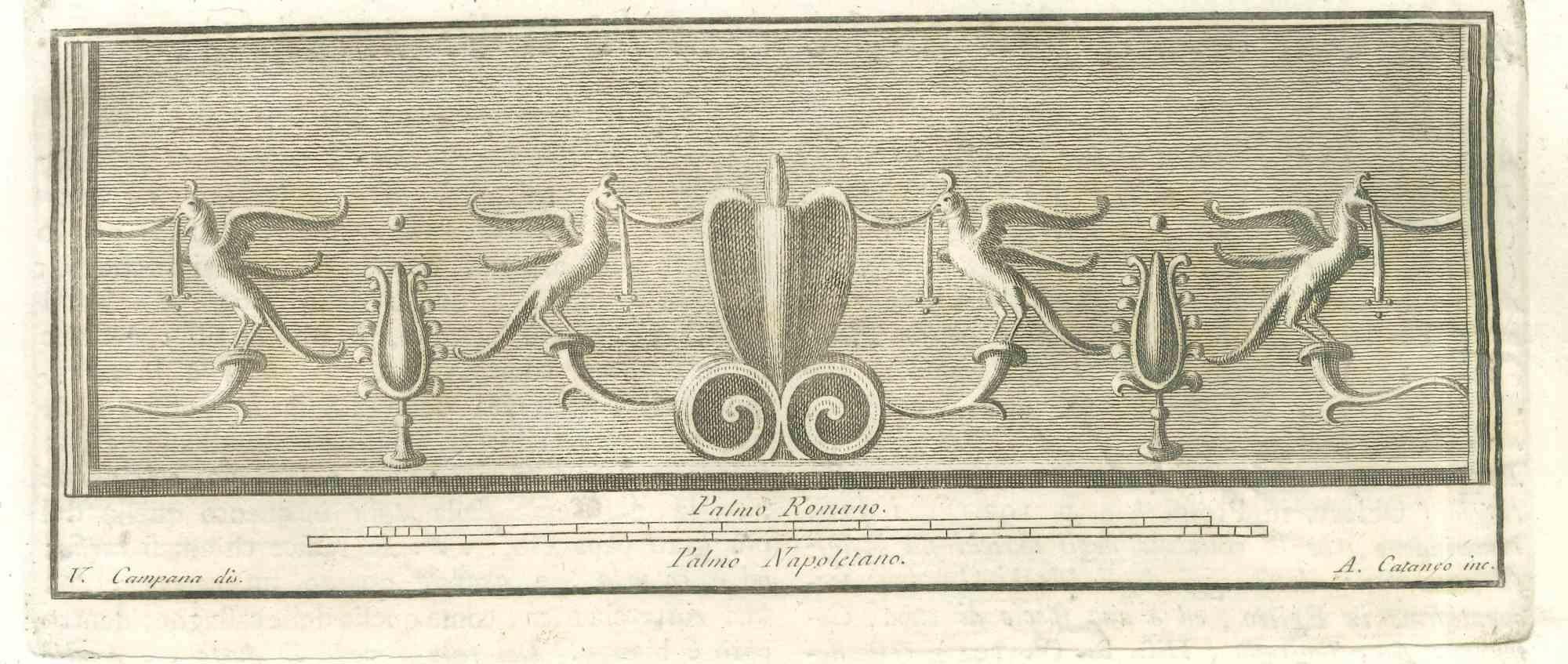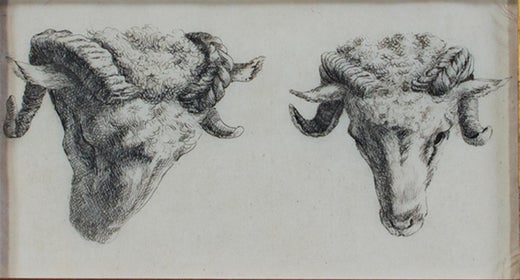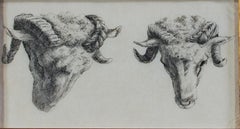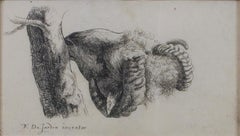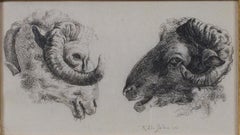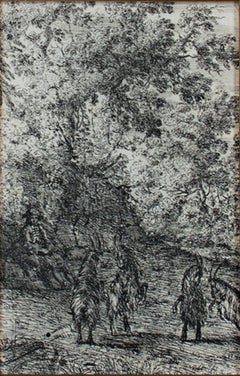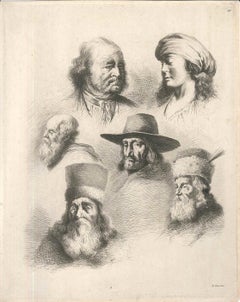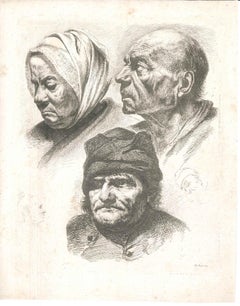Items Similar to 17th century etching animal print sketch ram sheep black and white signed
Want more images or videos?
Request additional images or videos from the seller
1 of 8
Karel Dujardin17th century etching animal print sketch ram sheep black and white signed17th Century
17th Century
About the Item
"Two Rams Looking Down, One Quarter View, One Straight Ahead" is an original etching by Karel DuJardin. DuJardin completed many delicate etchings of rams.
3 3/4" x 7 3/4" art
16 3/8" x 19 1/8" frame
Du Jardin was a master of various genres of painting, including refined and tranquil Italianising landscapes, monumental historical paintings and superb portraits of the aristocracy.
Unlike the majority of his contemporaries, Karel du Jardin (b. Amsterdam 1626, d. Venice 1678) was a talented painter in not one, but many different genres. He is especially famous for his small-scale landscapes, such as the charming Italian landscape with a woman milking a goa" (1652) from the Rijksmuseum's collection. Du Jardin depicted both sun-filled Italianate scenes and Dutch farmyards with pigs and sheep. He also painted a range of elegant portraits of aristocrats and merchants. His self-portrait (1662) on copper is one of the most fascinating 17th-century portraits of a Dutch artist. Du Jardin's spectacular large-scale historical pieces, represented is the show by the impressive Conversion of Saint Pau" (1662) from the collection of the National Gallery of London, are among his most remarkable achievements; he often chose themes that were only rarely depicted by other Dutch painters of the period.
During his own lifetime Du Jardin was praised by poets and writers, particularly for his attention to detail and elegant painting technique. As Cornelis de Bie, the artist’s biographer, wrote in 1661: "the surety of the brush at his finger and such sharpe clarity […] that the eye thereon doth linger." Du Jardin's valuable paintings were mainly purchased by rich individuals with an eye for elegance, but were also commissioned by prominent institutions such as the Amsterdam 'Spinhuis' (a women's prison), for whom he painted a vast group portrait of the prison-governors.
Karel du Jardin was an artist who liked to travel. He lived for a time in Lyon and in Paris, and sailed with Joan Reynst, Heer van Drakestein, by ship via England, Portugal and Spain to Tangier and Algiers, where they met Michiel de Ruyter. He lived out his final years in Rome (where he was nicknamed "the Goatee") and Venice, where he died in 1678. The suspected cause of death was food poisoning, after having spent a rather indulgent evening at the dinner table.
- Creator:Karel Dujardin (1626 - 1678, Dutch)
- Creation Year:17th Century
- Dimensions:Height: 16.375 in (41.6 cm)Width: 19.125 in (48.58 cm)
- Medium:
- Movement & Style:
- Period:
- Condition:
- Gallery Location:Milwaukee, WI
- Reference Number:Seller: 10687g1stDibs: LU60533169831
Karel Dujardin
Karel DuJardin was a Dutch painter and etcher, born in Amsterdam in 1622. Although active as a portrait and history painter, he is best known for his Italianate landscapes. Typical of his landscape paintings is Farm Animals in the Shade of a Tree (1656; National Gallery, London). Before traveling to Italy, DuJardin gained some success as an engraver. His pieces often depicted animals that showed their true nature. He would show some sleeping and others wallowing in the mud. Work animals were often shown, not at work, but grazing peacefully. His engravings are clear with bold and distinct lines. He also made a number of satirical engravings. As one historian put it, he was best known for his pictures of quacks. They would travel from village to village, present a bit of entertainment for the locals and then offer elixirs that did little more than empty the pockets of the villagers.
About the Seller
4.9
Gold Seller
Premium sellers maintaining a 4.3+ rating and 24-hour response times
Established in 1966
1stDibs seller since 2017
428 sales on 1stDibs
Typical response time: 2 hours
- ShippingRetrieving quote...Shipping from: Milwaukee, WI
- Return Policy
Authenticity Guarantee
In the unlikely event there’s an issue with an item’s authenticity, contact us within 1 year for a full refund. DetailsMoney-Back Guarantee
If your item is not as described, is damaged in transit, or does not arrive, contact us within 7 days for a full refund. Details24-Hour Cancellation
You have a 24-hour grace period in which to reconsider your purchase, with no questions asked.Vetted Professional Sellers
Our world-class sellers must adhere to strict standards for service and quality, maintaining the integrity of our listings.Price-Match Guarantee
If you find that a seller listed the same item for a lower price elsewhere, we’ll match it.Trusted Global Delivery
Our best-in-class carrier network provides specialized shipping options worldwide, including custom delivery.More From This Seller
View All17th century etching animal print sketch ram sheep black and white signed
By Karel Dujardin
Located in Milwaukee, WI
"Two Rams Looking Down & To Their Left" is an original etching by Karel DuJardin. DuJardin completed many delicate etchings of rams.
3 3/4" x 7 3/4" art
16 3/8" x 19 1/2" frame
Du Jardin was a master of various genres of painting, including refined and tranquil Italianising landscapes, monumental historical paintings and superb portraits of the aristocracy.
Unlike the majority of his contemporaries, Karel du Jardin (b. Amsterdam 1626, d. Venice 1678) was a talented painter in not one, but many different genres. He is especially famous for his small-scale landscapes, such as the charming Italian landscape with a woman milking a goa" (1652) from the Rijksmuseum's collection. Du Jardin depicted both sun-filled Italianate scenes and Dutch farmyards with pigs and sheep. He also painted a range of elegant portraits of aristocrats and merchants. His self-portrait (1662) on copper is one of the most fascinating 17th-century portraits of a Dutch artist. Du Jardin's spectacular large-scale historical pieces, represented is the show by the impressive Conversion of Saint Pau" (1662) from the collection of the National Gallery of London, are among his most remarkable achievements; he often chose themes that were only rarely depicted by other Dutch painters of the period.
During his own lifetime Du Jardin was praised by poets and writers, particularly for his attention to detail and elegant painting technique. As Cornelis de Bie, the artist’s biographer, wrote in 1661: "the surety of the brush at his finger and such sharpe clarity […] that the eye thereon doth linger." Du Jardin's valuable paintings were mainly purchased by rich individuals with an eye for elegance, but were also commissioned by prominent institutions such as the Amsterdam 'Spinhuis' (a women's prison), for whom he painted a vast group portrait of the prison-governors.
Karel du Jardin was an artist who liked to travel. He lived for a time in Lyon and in Paris, and sailed with Joan Reynst, Heer van Drakestein, by ship via England, Portugal and Spain to Tangier and Algiers, where they met Michiel de Ruyter...
Category
17th Century Old Masters Animal Prints
Materials
Etching
17th century etching animal print sketch ram sheep tree black and white signed
By Karel Dujardin
Located in Milwaukee, WI
"Ram Eating Bark" is an original etching by Karel DuJardin. DuJardin completed many delicate etchings of rams.
3 3/4" x 7 3/4" art
16 3/8" x 19 1/8" f...
Category
17th Century Old Masters Animal Prints
Materials
Etching
17th century etching animal print sketch ram sheep black and white signed
By Karel Dujardin
Located in Milwaukee, WI
"Two Rams Facing Each Other" is an original etching by Karel DuJardin. The artist signed the plate. DuJardin completed many delicate etchings of rams.
...
Category
17th Century Old Masters Animal Prints
Materials
Etching
17th century etching black and white landscape scene forest trees goats
By Claude Lorrain
Located in Milwaukee, WI
"Les Chevres (The Goats)" is an original etching by Claude Lorrain. It depicts two pairs of goats and a shepherd watching over them. This etching is also in the collections of the Me...
Category
1630s Old Masters Animal Prints
Materials
Etching
20th century etching animal print black and white cows farm scene sketch signed
By LeRoy Neiman
Located in Milwaukee, WI
"Bovine Family" is an original etching by Leroy Neiman. The artist signed the piece lower left. It is edition 182/250 and dated 1980. It depicts a cow an...
Category
1980s Modern Animal Prints
Materials
Etching
19th century black and white etching aquatint outdoors figurative animal print
By Camille Pissarro
Located in Milwaukee, WI
"Vachere au Bord de L'Eau" is an original etching and aquatint by Camille Pissarro, the 8th state. It can be found in the catalogue raisonne Delteil #93. It features a woman sitting ...
Category
1890s Realist Figurative Prints
Materials
Etching, Aquatint
You May Also Like
Gran Grue Della Baia d'Hudson - Etching by Andrea Scacciati The Younger
By Andrea Scacciati
Located in Roma, IT
Gran Grue Della Baia d'Hudson is a beautiful black and white etching on laid paper realized by the Italian artist, Andrea Scacciati. Title engraved on the higher margin, inscription ...
Category
1760s Old Masters Animal Prints
Materials
Etching
Study of Six Heads - Etching by J.-J. Boissieu
By Jean-Jacques de Boissieu
Located in Roma, IT
Study of Six Heads is a beautiful black and white etching with drypoint interventions on paper, realized at the end of XVIII century by the French artist Jean-Jacques de Boissieu (Lyon, 1736- 1810).
Six study od heads ( four elder men, a middle-aged man at the center, and a woman with turbant) etched with a superb technique and an incredible draftsmanship are drawn to different scales and with different degrees of finish, have the dignity of six different portraits with the same passion and effort.
Signed on plate on lower right margin “De Boissieu”. Inscription ( number plate) on higher-right corner "10".
This old master’s original print with lifetime impressions, is in very good conditions, except for a usual yellowing of the paper above all on the edges and some signs of the time,do not affect the image.
Jean-Jacques de Boissieu (Lyon,1736 –1810)
Jean-Jacques de Boissieu was a French artist studied at the École de Dessin in Lyon, but he was mostly self-taught.
His first prints were realized between 1758–64. When he went to Italy in the retinue of the ambassador and Duc de la Rochefoucauld d’Enville, he had the lifechanging encounter: he met Voltaire and he entered in the world of luminaries, he had the opportunity of realizing some plates for the Diderot-d’Alembert’s Encyclopèdie. Then he continued to produce prints in Lyon, Boissieu made many etchings of the Roman and Dutch countryside, as well as the French countryside around Lyon, which earned him a reputation as the last representative of the older etching...
Category
Late 18th Century Old Masters Animal Prints
Materials
Drypoint, Etching
Study of Five Heads - Original Etching by J.-J. Boissieu
By Jean-Jacques de Boissieu
Located in Roma, IT
Study of Five Heads is a beautiful black and white etching with drypoint interventions on paper, realized at the end of XVIII century by the French artist Jean-Jacques de Boissieu (Lyon, 1736- 1810).
Five study of heads of which two profiles (a female and a male) are lightly sketched with the drypoint technique, and we could appreciate the incredible draftsmanship. Instead, the bigger three portraits are very detailed and etched with a superb technique. Although the subjects are drawn in different scales and with different degrees of finish, each portrait has the dignity of a unique piece and the composition is very balanced.
In particular on the lower margin at the center there is the portrait of "Le Père Cotrot, Garçon Teinturier à Lyon'", an elderly man, toothless and with a large-nosed, slightly turned to left, with a hat and unbuttoned jacket over waistcoat, shows all his wrinkles in a very realistic way.
Signed on plate on lower right margin “De Boissieu”.
This old master’s original print with fresh impressions, is in very good conditions, except for a usual yellowing of the paper above all on the edges and some signs of the time and light foxing along the margins, do not affect the image.
Jean-Jacques de Boissieu (Lyon,1736 –1810)
Jean-Jacques de Boissieu was a French artist studied at the École de Dessin in Lyon, but he was mostly self-taught.
His first prints were realized between 1758–64. When he went to Italy in the retinue of the ambassador and Duc de la Rochefoucauld d’Enville, he had the lifechanging encounter: he met Voltaire and he entered in the world of luminaries, he had the opportunity of realizing some plates for the Diderot-d’Alembert’s Encyclopèdie. Then he continued to produce prints in Lyon, Boissieu made many etchings of the Roman and Dutch countryside, as well as the French countryside around Lyon, which earned him a reputation as the last representative of the older etching...
Category
Late 18th Century Old Masters Animal Prints
Materials
Drypoint, Etching
Decoration With Animals - Etching by Luigi Aloja - 18th Century
Located in Roma, IT
Decoration With Animals is an Etching realized by Luigi Aloja (1783-1837).
The etching belongs to the print suite “Antiquities of Herculaneum Exposed” (original title: “Le Antichit...
Category
Late 18th Century Old Masters Figurative Prints
Materials
Etching
Bird Fresco - Etching by Giuseppe Aloja - 18th Century
Located in Roma, IT
Bird Fresco from "Antiquities of Herculaneum" is an etching on paper realized by Giuseppe Aloja in the 18th Century.
Signed on the plate.
Good conditi...
Category
18th Century Old Masters Figurative Prints
Materials
Etching
Animals Pompeian Fresco - Etching by Aniello Cataneo - 18th Century
Located in Roma, IT
Animals Pompeian Fresco from "Antiquities of Herculaneum" is an etching on paper realized by Aniello Cataneo in the 18th Century.
Signed on the plate.
Good conditions.
The etching...
Category
18th Century Old Masters Figurative Prints
Materials
Etching
Recently Viewed
View AllMore Ways To Browse
Old England Paris
White Sheep
17th Century Copper
17th Century Ship
Antique England Etching
17th Century Portuguese
Portugal Old Master
Italian Sheep
17th Century Dutch Table
Antique Sheep Print
Antique Milk Sign
Italianate Tables
Antique Poison
Antique Portuguese Scales
Pauly Venice
Portuguese Table 17th
Antique Milk Scale
Antique Milk Scales
